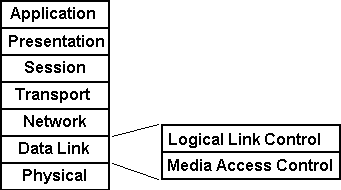The OSI Data Link Layer
By Stephen Bucaro
The Data Link layer (OSI layer 2) contains two sub-layers; the Logical Link Control
(LLC), and the Media Access Control (MAC). IEEE specification 802.2 defines the LLC,
while the IEEE specifications 802.3 and 802.5 define the MAC for Ethernet and Token Ring.

All hosts on a network, including network devices such as printers and routers,
must have a unique identifier called the Media Access Control address. The Data
Link layer uses MAC addresses is to pass data frames from the Physical layer to the Network
layer and vice versa. The use of MAC addresses permits the direction of data within
the same network, but not across routers.
The Bridge and Switch
The major network device that operates at the Data Link layer is the bridge and switch.
The bridge stores a list of MAC addresses that are connected to each of its ports. It reads
the destination MAC address in each packet it receives. Because the bridge does not modify
the packet in any way, the process is called transparent bridging.
If the destination is on the same network segment the bridge discards the packet.
If the destination is on a different segment, the bridge forwards the packet to the
proper segment. If the bridge’s MAC address table does not list the destination, the
packet is forwarded to all segments except the segment of origin and waits for a
device to respond. If a device responds, the bridge can update its MAC address table
to include that MAC address.
A switch is similar to a bridge in the way it forwards packets through a network,
except the switch can forward packets between ports simultaneously. A switch can
segment a network into as many parts as the number of ports the switch has. In an
entirely switched network, each device connects to a switch rather than a hub. This
allows for the speed of the network to be the combined speed of all the ports.
The Bridge

| 
